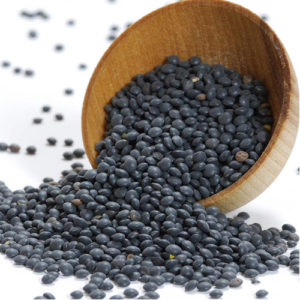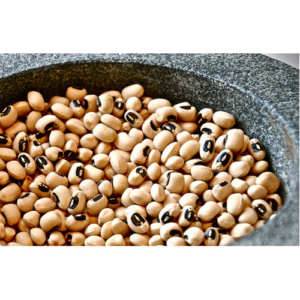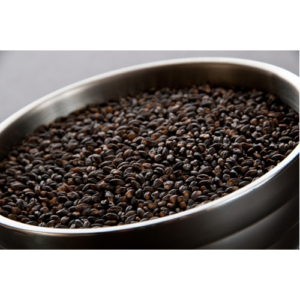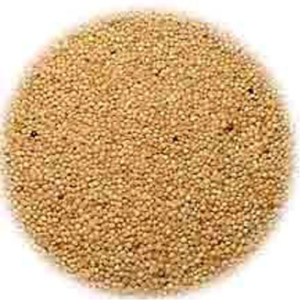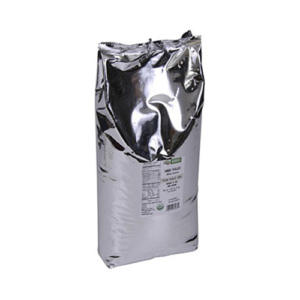- Display 15 Products per page
-
BLACK LENTILS
Black Lentils are a very popular legume in South Asia, they are used to make a beautiful black lentil soup. Black Beluga Lentils are 1/2 cm. wide with a mild, earthly flavor and soft texture. This tiny lens shaped pulse has traditionally been used as a meat substitute (A pulse is the dried seed of any legume, such as beans and peas). Lentils are the seed of a small shrub and are dried after harvesting.
Suggested Use:The quick cooking and nutritious nature of lentils make them an obvious choice for winter soups. They’re delicious in chilled vegetable salads, or mix with bread crumbs, minced onion and garlic to stuff roasted red peppers or eggplant.
Basic Prep:Lentils do not require soaking. Simmer 1 cup lentils with 4 cups water 12 minutes for salads, 20 to 30 minutes for main dishes, drain. Skim the water while cooking. One cup dry yields 2 cups cooked.
-
BLACK EYE PEAS
Black Eyed Peas (Vigna Unguiculata) are related to the Mung Bean. These beans are medium sized cream colored beans with a ‘Black Eye’ on the inner curve of the bean. Black Eyed Peas are about 3/8 long and have a sweet, mild pea-like flavor and firm texture. The Black Eyed Pea absorbs the flavors of a dish very well. Also referred to as a Black Eyed bean, Cow Pea, Field Pea, Tonkin Pea, China Pea, Marble Pea, Brown Eyed Pea, Jerusalem Pea, Black Eyed Suzy and Lobhia.This bean is believed to have originated in Eastern Asia. It was brought to the Americas with the African slave trade. Black Eyed Beans were a staple of many plantation diets. Eaten on New Year’s Day, Black Eyed Beans are thought to bring good luck for the following year.
Suggested Use:This fast cooking legume lends itself to many recipes. It mixes well with a variety of greens, including Okra, Collard and Swiss Chard. Hoppin’ John is a traditional souther recipe using this bean.
Basic Prep:Soak overnight. Rinse and place in a large pot and cover with fresh water. Bring water to a boil for 3 minutes, reduce heat and simmer, covered, for 30-45 minutes until tender. Do not over stir or the soft skins can be damaged. One cup dry yields 2 cups cooked.
-
BLACK BARLEY
Black Barley is also known as Purple Hull-less Barley. Originally from Ethiopia, this variety has not been raised until recently because of the low yield. This is actually the only grain that can go from field to table without being processed, because the gloom or bran layer stays attached to the kernel, and is edible.
Suggested Use:The shape of this hearty grain resembles a coffee bean and cooks to a glossy purplish-mahagony color. It is wonderful in soups and stuffings or alone as a beautiful alternative to rice (Because of a somewhat chewy texture, it is best mixed with other grains.)
Basic Prep:Rinse well, add 1 cup of barley to 3 cups of boiling water. Simmer covered 35-40 minutes until liquid is absorbed. For a fluffier grain, soak Barley in water for 5 hours then simmer covered for 15 minutes. One cup dry yields 3-1/2 to 4 cups cooked.
-
AMARANTH GRAIN
Organic Amaranth Grain dates back hundreds of years to the Aztecs in Mexico. It offers an unusually high quality protein and is high quality protein and is high in fiber. Amaranth Grain has a nutty flavor and can be combined with wheat flour in breads, pasta, pancakes and other recipes. Available in 25 LB master cases or 5 LB partial bags.
-
AGRIBOSCO FARRO, ORGANIC
First cultivated in the ancient fields of Babylon, the rustic grain farro is now a central cereal grain for chefs. Del Destino Italian Semi-Pearled Farro is certified USDA organic and has a forgiving, fibrous texture that boasts a complex, nutty taste offering hints of oat and barley. Farro is the ideal alternative to rice in applications like risotto and soups.

